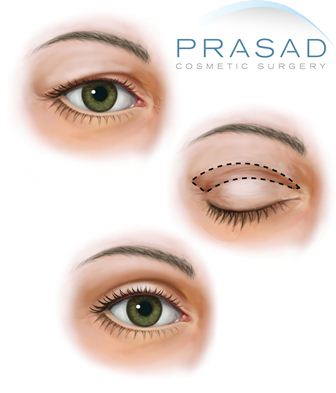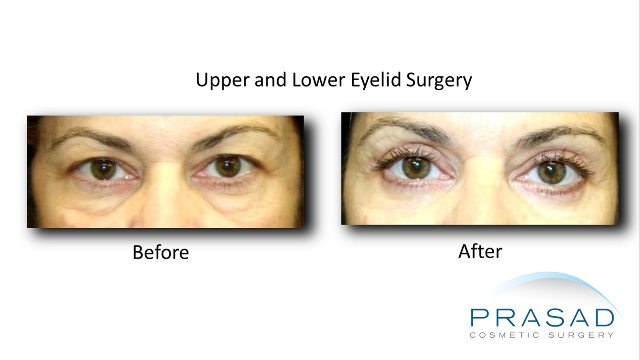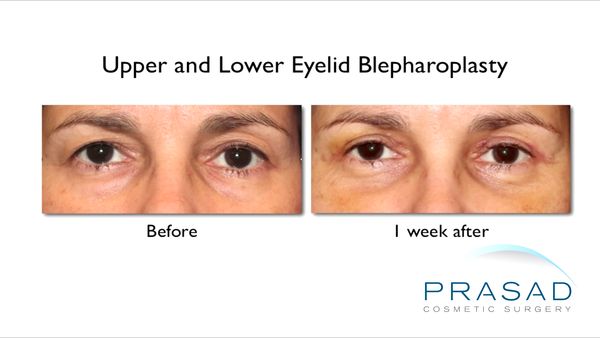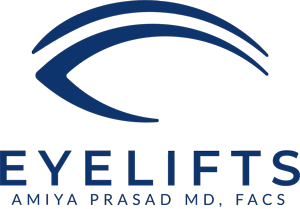Upper Eyelid Surgery
Upper eyelid surgery, or upper blepharoplasty, is a surgical procedure that is performed in order to correct defects and deformities on the eyelids. It is also a procedure done to address cosmetic problems that involves restoring the natural line of the eyelid, and the removal, excision and repositioning of skin, fat, muscle and tendon tissues of the eyelids. Blepharoplasty is sometimes also referred to as “eye lift surgery”, which is slightly misleading as the eyelid is not “lifted” during the procedure. It can be performed on the upper and lower eyelids.
The Way the Eye Ages
The eyes are one of the most complex and delicate structures in the body. It is so delicate, in fact, that even the simple act of blinking weakens and stretches an important muscle in the eyelid, called the levator muscle, which is responsible for lifting the eyelid.
As we age, several changes occur around the eye. First, the extremely thin skin surrounding the eyes becomes more and more prone to damage and wrinkling; second, the delicate fibers that make up the muscles around the eye lose their elasticity and begins to weaken; and third, the fat around the eye that gives it the youthful volume and suppleness is slowly depleted.
One such symptom that occurs is called dermatochalasis. This refers to excess sagging skin that weighs down the upper eyelids, giving it a hooded appearance. In severe cases of dermatochalasis, a person’s vision may become obstructed so skin will need to be surgically removed via blepharoplasty.
 |
 |
Dermatochalasis is excess or stretched eyelid skin that makes the eyes hooded, and can obscure vision. This is the most common reason for age-related blepharoplasty.
Since the eyes are the most prominent feature on our faces, these changes are often immediately spotted and not always for the best reasons. Before you know it, you’re suddenly hearing comments like “are you sick?’’, “did you sleep at all last night?”, and “are you tired?” more often than you’d like.
When is Upper Blepharoplasty Performed?
Coupled with undesirable lifestyle habits such as smoking, drinking and excessive sun exposure, the aging signs around the eyes can become quite pronounced, giving way to saggy and tired-looking eyes that can make you look prematurely old. For most people, the turning point in deciding whether or not to address these aging signs often comes when they begin to be perceived to be older than they actually are, or look older than they feel.
According to Dr. Amiya Prasad, there is no ideal age for blepharoplasty because the need for eye rejuvenation differs greatly for every individual. Some people who have been saddled with genetic eyebags or hollowness around the eyes since birth may feel the need to have surgery much earlier; genetic eye bags can be removed in the teens, and hollowing can be treated non-surgically in the 20s and 30s. Others decide to rejuvenate sagging eyelids well into their 70s and beyond. It ultimately depends on how an individual’s eyelid skin and soft tissue ages, and their personal cosmetic goals.
Upper Eyelid Surgery Before and After

The appearance of the eyes can mask your true age or the youthfulness you feel. Natural-looking eyelid rejuvenation make a profound impact on your overall appearance
Who is a Good Candidate for Upper Eyelid Surgery?
Over the years, an increasing number of people with thriving careers in high-powered and competitive industries more often seek out blepharoplasty procedures in order to look like they’re still “in the game”. In fact, according to the American Society for Aesthetic Plastic Surgery, blepharoplasties have far exceeded facelifts and rhinoplasties in popularity. This is because many of these successful executives understand, based on experience, that looking refreshed and full of energy plays a positive role in the way people perceive and interact with them. Regardless of your age, the truth of the matter is that looking as young and robust as you actually feel gives you a competitive edge in any industry.

This lady’s eyes first appeared tired and aged, but eyelid rejuvenation gave her entire face a more youthful and energetic quality.
That being said, here are some basic points that can help you determine if you’re a candidate for blepharoplasty:
- You are constantly being asked if you are: (1) tired, (2) sick, (3) getting enough sleep.
- People constantly perceive you to be older than you actually are, even though you feel youthful and energetic.
- You feel that you are working in an industry that places some importance in looking youthful, and you feel like you may lose out on opportunities because you are perceived to be older or “less important”.
- There is significant excess skin over your upper eyelids which obscures the real shape of your eyes and affects your line of sight.
- You feel frustrated when applying makeup on your eyes, particularly eye shadow, because the excess skin causes it to crease.
- You want your eyes to appear brighter and more alert and youthful.
- You have realistic expectations when it comes to achieving a younger and fresher look.
- You are doing it because you have personally made the decision to go ahead with it, not because you are being forced or pressured into it by other people.
- You are generally in good health.
Dr. Prasad’s SmartLift Eyelift
Upper eyelid blepharoplasty is designed to remove excess skin and hooding on the upper lids and is quite a straightforward procedure. Oculoplastic surgeon Dr. Amiya Prasad pioneered a particular technique in blepharoplasty surgery which he calls the SmartLift eyelift. It entails the use of minimal incisions with local anesthesia, and yields very natural-looking results. The SmartLift eyelift differs from traditional eyelid blepharoplasty surgery because it involves minimal risk, minimal anesthesia and maximal results.
How is upper eyelid surgery done?
After a careful and thorough examination, the area is cleansed, after which a local anesthesia is administered. With the SmartLift eyelift, Dr. Prasad always makes use of local anesthesia with LITE™ IV Sedation during his procedures, as opposed to general anesthesia, as it allows his patients to deal with less downtime and less symptoms of bruising and nausea. Since the patient isn’t healing from the effects of general anesthesia post-surgery, incisions heal better and faster, thus helping patients recover sooner.
Once the area is numb, a minimal incision is made, through which Dr. Prasad is able to sculpt or remove fat and tissue. When this is completed, the skin and muscles are re-positioned (to allow for less bruising) and the incision is stitched closed.
According to Dr. Prasad, the act of creating an incision in the correct place (right at the point where the upper eyelid creases) and the method of suturing it closed afterwards is considered more of a work of art than a technique. Surgeons with less experience in eye surgery will often leave patients with obvious scars that fall outside the crease; however, if done correctly, no scar should be noticed at all.
Overall, the entire procedure should last about 1-2 hours, depending on the extent and complexity of the individual’s case.
What to Expect After Upper Blepharoplasty?
You can expect to see some temporary and minimal bruising and swelling, which is typical after having eyelid surgery. These symptoms, however, should lessen in 7-10 days due to Dr. Prasad’s minimal risk technique. Patients may opt to undergo platelet-rich plasma treatment in order to speed up healing even more, if needed.

Temporary swelling and bruising is normal after eyelid surgery, but healing time is drastically reduced with the use of local anesthesia.
During the recovery period, patients must be wary of taking certain medications and supplements which can interfere with the healing process. This is why it is important for patients to inform their surgeon, even before any surgeries are performed, of any medications they may be taking. Contact lenses may be worn about two weeks after the procedure.
Ethnic Considerations for Upper Eyelid Surgery
Since skin is so vastly diverse, several considerations need to be made, especially when it comes to people of other ethnicities. Depending on ethnicity, skin may be thicker, more prone to visible scarring, have more melanin and pigment, and have a greater tendency to sag.
Darker-skinned individuals must understand that certain incisions may heal differently in skin that has more melanin—in fact; facial scars are known to thicken and form keloids in people with darker skin tones. Utmost care and delicacy must be exercised to ensure that this does not occur, otherwise, a patient may be left with obvious scars. As a surgeon with extensive experience in performing ethnic eye plastic surgery, Dr. Prasad is confident in his capability to reduce the risk of keloid formation after surgery in his patients.
Asian Eyes
About half of people of Asian descent have double eyelids otherwise referred to as a defined eyelid crease, while the other half a single fold. Creating an eyelid crease is popular among Asians hence the name Asian eyelid surgery is used interchangeably with Asian eyelid surgery or Asian double eyelid surgery. This procedure creates the much desired eyelid crease, and can open up the eyes more.
Asian eyes are also unique in that they can have an extra bit of webbed skin in the inner corners known as the epicanthal fold. Some people of Asian descent want to change or remove this unique feature of the eye in a procedure called an epicanthoplasty. Dr. Prasad generally does not advise or perform epicanthoplasty due to the risky nature of the procedure and its unpredictable results.
Dr. Amiya Prasad, a Top Cosmetic Eye Surgeon based in New York
With over 20 years of experience and two ongoing practices in Manhattan and Garden City, Long Island, Dr. Prasad is a well-known figure in his field. He is Board-certified and a fellow of The American Society of Oculofacial Plastic and Reconstructive Surgery (ASOPRS), an exclusive professional society with highly stringent criteria for membership, of which only about 500 specialists worldwide are members of. Dr. Prasad was first trained in Ophthalmology or surgery of the eyes, and then later on specialized in Oculofacial Plastic Surgery that focuses on specialized cosmetic and reconstructive eye surgery.
Dr. Prasad is also a super-specialist, which is a term that refers to someone who has undergone a rigorous amount of training in a particular field, and has garnered enough experience and certifications that amounts to superior-specialization in the eyes. Dr. Prasad is highly sought after for his finely perfected surgical techniques, his eye for detail, and his artistic approach to surgery—all of which result in beautiful, natural-looking, and rejuvenated faces that still maintain their unique characteristics.
It is essential that you meet with a seasoned professional who specializes in these types of surgeries before committing to anything. Dr. Amiya Prasad is available for consultations and is ready to help you decide the best course of action for your case. Set an appointment with us today at our Manhattan office at (212) 265-8877 or our Garden City, Long Island office at (516) 742-4636. Our lines are open 24 hours a day, 7 days a week.
